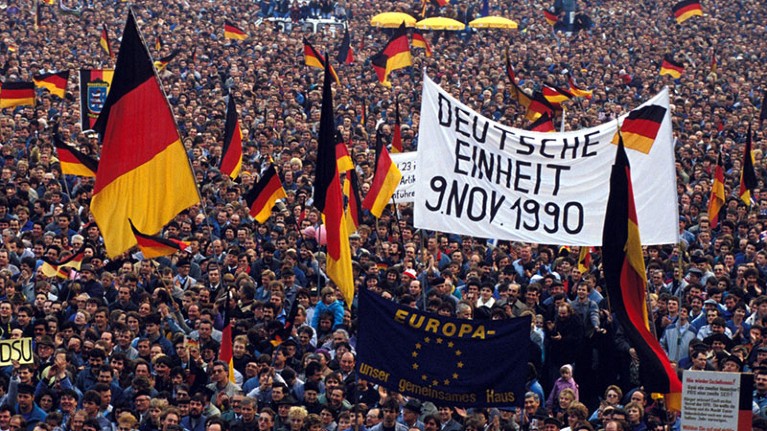
Celebrations of Germany’s reunification, which would lead to the entry of central and eastern European nations into the European Union.Credit: Patrick Piel/Gamma-Rapho via Getty
On the night of 9 November 1989, young and old began to dismantle the Berlin Wall. Brick by brick, they broke down the 3.6-metre-high structure, which formed part of the border between communist East and capitalist West Germany. Those unforgettable scenes changed the world’s political map. They led to Germany’s reunification and played a significant part in the liberation of central and eastern European countries from the Soviet yoke and their subsequent entry into the North Atlantic Treaty Organization and the European Union.
Those were heady months. The political philosopher Francis Fukuyama excitedly called the expansion of western-style liberal democracy “the end of history”. But, as we now know, such a statement was not only premature, it also masked a much more complex reality of international relations that is still playing out today.
For scientists in central and eastern Europe, the end to more than four decades of isolation was a big win. More research transferred to universities, and away from the old, state-supported academies of science. With that came new sources of funding from the European Union — amounting to €25 billion (US$28 billion) in the present round.
But the abrupt transition to a market economy, and the ending of many state subsidies for the less-well-off in former communist countries, also took their toll. Economic hardship in the early 1990s helped drive many researchers to pursue careers in the West. This exodus of academics contributed to an intellectual void, from which Russia and Ukraine, especially, haven’t fully recovered.
But it was different for science institutions in western Europe, and more globally. Fresh ideas and new talent were welcomed. One result is the experimental fusion reactor ITER, developed by Soviet-era researchers in the late 1960s and now being constructed in France. The International Space Station is another.
But there’s some distance to go before the scientific gains of an expanded EU can be more fully shared. Spending on research and development in central and eastern Europe averages at 1% of gross domestic product(GDP) — considerably below the EU average of 2.07%.
Some countries, such as the Czech Republic and Slovenia, have caught up in recent years. But others, including Romania, Bulgaria and Croatia, spend even less than 1% of their GDP on research and development. EU member states from central and eastern Europe that are home to one-fifth of the bloc’s 500 million inhabitants gain less than 5% of the €80-billion Horizon 2020 research programme. This must change — and it will if national governments start to ramp up their own domestic investments and work harder to improve the quality of their research.
One of the biggest paradoxes of the past 30 years is Russia. The epicentre of Soviet power, Russia under Mikhail Gorbachev in the mid-1980s began to look West, helping to precipitate the fall of the Berlin Wall. Today, the international atmosphere is closer to that of a new cold war. Russia and the EU, with the United States, are on opposite sides of crucial foreign-policy controversies, and both Russia and the United States are pulling away from key arms-control agreements, notably the Intermediate-range Nuclear Forces Treaty.
And although Russia remains part of many international scientific projects, in some cases it is choosing to seek scientific partnerships to its east and south, including with the BRICS countries — Brazil, Russia, India, China and South Africa — and with others in Africa, Latin America and Asia. A new divide seems to be opening up between researchers in the East and West.
If a new cold war is coming, the lessons from science’s cold-war history need to be dusted down. US president Lyndon Johnson and Russia’s premier Alexei Kosygin agreed that — other differences notwithstanding — their nations would collaborate in science. One result was the founding in 1972 of the International Institute for Applied Systems Analysis in Laxenburg, Austria, which is still going strong.
Among the larger EU states, Germany clearly understands the need to keep an open door for researchers, and remains actively involved with Russian research. A call for proposals for joint German–Russian projects in all fields of science, launched last month by the German Research Foundation and the Russian Science Foundation, promises to strengthen scientific links between the two countries. Russia’s logistical support of MOSAiC, a German-led one-year Arctic expedition launched in September, highlights the feasibility of East–West scientific partnerships even in troubled political times.
Thirty years of research cooperation since the cold war ended has done much more than just help to keep the peace. But a strong dose of that original spirit — which kept cold-war collaborations alive — is still needed. The journey to successful East–West collaboration is far from over.

 Trapped: why 300 scientists are locking themselves in Arctic ice
Trapped: why 300 scientists are locking themselves in Arctic ice








